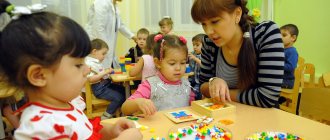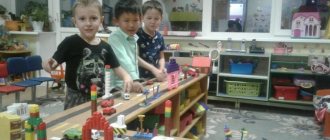Long-term work plan for life safety in the preparatory group
Long-term plan
on the formation of security foundations
in the preparatory group
Goal: Formation of the foundations for the safety of one’s own life and the formation of prerequisites for environmental consciousness (safety of the surrounding world).
Tasks:
- formation of ideas about situations that are dangerous for humans and the natural world and methods of behavior in them;
- introducing the rules of behavior that is safe for humans and the natural world around them;
- transferring to children knowledge about road safety rules as a pedestrian and a passenger in a vehicle;
- developing a cautious and prudent attitude towards situations that are potentially dangerous to humans and the natural world.
Safe outdoor recreation
To form the foundations of environmental culture and safe behavior in nature.
To form the concept that everything in nature is interconnected. That a person should not violate this relationship so as not to harm the animal and plant world.
To introduce the phenomena of inanimate nature (thunderstorm, thunder, lightning, rainbow), and the rules of behavior during a thunderstorm.
Introduce children to the rules of first aid for bruises and insect bites.
Road safety
Clarify children's knowledge about the elements of the road (roadway, pedestrian crossing, sidewalk), about traffic flow, and about the operation of traffic lights.
Familiarize children with the names of the streets closest to kindergarten and the streets where children live.
Familiarize yourself with the rules of the road and the rules for the movement of pedestrians.
To consolidate and expand knowledge about the rules of cycling.
Continue to familiarize children with road signs: “Pedestrian crossing”, “Children”, “Bus stop”, “Medical aid point”, “Food point”, “Parking area”, “No entry”, “Road works”, “Bicycle path” "
Personal safety
Introduce the work of the rescue service - the Ministry of Emergency Situations.
Reinforce the fundamentals of human life safety.
Strengthen the ability to say your first and last name, home address.
Continue to introduce the rules of behavior during games at different times of the year (swimming in reservoirs, cycling, sledding, skating, skiing, etc.)
Expand knowledge about sources of danger in everyday life (electrical appliances, gas stove, iron, etc.)
Strengthen the skills of safe use of household items.
Clarify children's knowledge about the work of firefighters, the causes of fires, and basic rules of behavior during a fire.
Develop the ability to seek help from adults.
To consolidate the knowledge that, if necessary, adults call “01” (in case of fire), “02” (call the police), “03” (Ambulance).
By the end of the year the child:
Complies with the basic rules of organized behavior in kindergarten.
Observes basic rules of behavior on the street and in transport, basic traffic rules.
Distinguishes and names special types of transport (“Ambulance”, “Fire brigade”, “Police”), explains their purpose.
Understands the meaning of traffic lights. Recognizes and names road signs “Pedestrian crossing”, “Children”, “Public transport stop”, “Underground pedestrian crossing”, “Medical aid station”.
Distinguishes between roadways, sidewalks, underground pedestrian crossings, and Zebra crossings.
Knows and follows the basic rules of behavior in nature (ways to safely interact with plants and animals, respect for the environment).
Long-term work plan:
“Formation of the basics of safety in preschoolers.”
Preparatory group
Contents of the OOD
08.09
Personal safety
Modeling the situation “I’m lost”
Goal :
consolidate knowledge of home address, full name. parents' patronymics. Develop the ability to seek help from adults. To form knowledge about “strangers” and “our own”. Explain to children what dangers may await them when in contact with strangers. Explain safe behavior when interacting with strangers.
D/i “Postman” Purpose: to consolidate the knowledge and ability to be able to name your full name and address
15.09
Road safety
Modeling the situation “Safe behavior on the street and in transport.”
Target:
find out the child’s readiness to act correctly in the current situation on the road or in transport. (“How to teach children traffic rules”, T.P. Garnysheva
22.09
Safe outdoor recreation
Conversation:
Poisonous mushrooms and berries
.
Target:
Explain to children that a person’s life and health depends on how he knows how to deal with nature. Introduce the rules of behavior in nature, consolidate knowledge about poisonous mushrooms. Reviewing encyclopedias about mushrooms and berries. Making riddles about mushrooms and berries.
C/game “In the Forest”. Goal: to promote the development of knowledge about nature. To develop an understanding of the need for humans to observe the rules of behavior in nature.
29.09
Fire safety rules
Thematic story "Firefighter". Target:
introduce the history of the Firefighter profession. Check your knowledge of the telephone number to call the fire brigade. Learn to answer the teacher's questions.
D/ game “RESCUERS” Purpose: to develop the ability to correlate a schematic image with a natural object; stimulate the development of visual perception, teach to find an object by its schematic image.
Reading S. Marshak “The Story of an Unknown Hero”
06.10
Personal safety
“Whoever starts the day with exercise will do well.”
Target:
instilling healthy lifestyle skills. Teach children, together with an adult, to create a list of exercises and then complete them.
13.10
Safety in nature.
Conversation “We will preserve and protect nature”
Target:
to educate children in environmental behavior, to develop ideas about what actions harm nature and what contribute to its restoration.
Looking at illustrations on the topic “How to behave in nature»
D/I “how to avoid trouble in nature”
Target
: promote the development of knowledge about nature and safe behavior in nature
20.10
Road safety
Situational conversation: “We are not afraid on the street” Purpose:
Establish traffic rules for drivers and pedestrians. To consolidate knowledge of traffic light signals and their purpose. Cultivate attention and focus on the road.
LOTTO “Road Signs” Board and printed games “Road Signs” Purpose: to consolidate knowledge about road signs.
27.10
Fire safety rules
Conversation: “This match is small.”
Reading S. Marshak “The Tale of Matches”, conversation on content. D/i "Fire hazardous items".
03.11
Personal safety
Conversation: “Household things can be dangerous: don’t leave needles, scissors and paper clips on a stool.” Target:
Expand your understanding of life-threatening objects that are found in everyday life. Tell children that there are many dangerous objects that you need to know how to use, that they should be stored in specially designated places
. D/game: “Dangerous - not dangerous.” Goal: To teach children to distinguish life-threatening situations that threaten their health and the health of others from non-hazardous ones; be able to foresee and prevent the results of possible developments of the situation; reinforce and follow the rules of safe behavior in various situations; develop a protective self-awareness.
D/game: “I will name the item, and you will tell me about the rules for its use.” Goal: to consolidate the rules for handling dangerous objects.
10.11
Road safety
Conversations: “Two traffic lights”, “Rules for pedestrians”.
Goal: To expand children's knowledge about the rules of behavior on the street. D/I “Sparrows and the car” Purpose: to consolidate the acquired knowledge about the Rules of the Road.
18.11
Fire safety rules
D/I “How will I put out a fire?”
Purpose:
to explain that not all objects and methods are suitable for extinguishing a fire.
Teach children to name fire extinguishing agents: fire extinguisher, sand, water, etc. “Rules for evacuation in case of fire” Purpose
: to consolidate the rules for evacuation in case of fire from a kindergarten. Know how to behave in heavy smoke. Learn to remain calm, collected, and cultivate a sense of responsibility.
25.11
Safety in nature.
Telling children “Winter”
Purpose:
to consolidate children’s knowledge about behavior on the street, namely: winter games cannot be held on the roadway, in winter you cannot walk under the canopy of houses, it is dangerous to go out on the ice.
Game training “Rules of behavior on ice” Purpose:
introduce prohibitive rules of conduct on ice. Develop a sense of self-preservation, the ability to avoid tragic situations.
01.12
Personal safety
Conversation “The kitchen is not a place for games” Purpose:
clarify children's understanding of the dangers lurking in the kitchen. Familiarity with the rules of communication with domestic and street animals. Simulation of the situation “Meeting with a strange dog” Assignment: remember what the calf Gavryusha did with the postman Pechkin in Prostokvashino. Conversation “Cats can be dangerous too”
08.12
Road safety
Story-conversation about directional signs:
“Bus and (or) trolleybus stop”, “Pedestrian crossing”, “Underground pedestrian crossing”, “Parking place”, etc. Goal: Consolidating knowledge about information and directional signs D/i “Guess what sign?” Goal: To teach children to distinguish road signs, to consolidate children’s knowledge of traffic rules; develop the ability to independently use the acquired knowledge in everyday life.
15.12
Safety in nature.
Conversation “Animals”
Target
: explain that contact with animals can be dangerous, teach them to take care of their safety.
Situation “Meeting with an unfamiliar animal”
Target:
Teach the correct handling of unfamiliar animals, familiarize them with the rules of behavior in dangerous situations.
22.12
Fire safety rules
conversation and modeling of situations on the topic
: “
We’re decorating the Christmas tree.”
A conversation with an examination of illustrations about the rules of behavior near the Christmas tree, actions with dangerous objects (crackers, sparklers, etc.). D/i “It burns - it doesn’t burn.”
12.01
Personal safety
Conversation “On the playground”
Target:
to form children’s understanding of the sources of potential danger on the playground and the rules of safe behavior when walking.
Joint discussion between the teacher and children “Rules of behavior in the kindergarten area during a walk” Purpose
: teach to follow the rules of safe behavior on the site, remind them of the dangers that await them on the site.
Looking at illustrations and pictures.
19.01
Fire safety rules
Compiling a story on the topic “Where can trouble come from?” or “Why did this happen?”
with a beginning or an end suggested by the teacher. Game-activity “What should not be done in the absence of adults.” Reading S. Marshak “Cat House”
26.01
Road safety
Conversation: Streets are different.
Goal: to systematize children’s knowledge about the structure of the street and traffic. Introduce the concepts of “square”, “boulevard”, “prospect”. D/i: “Prohibited - allowed” D/ and “Rules of conduct” Purpose: To reinforce the rules of behavior with children; discuss various dangerous situations that may arise when playing in the courtyard or on the street; teach necessary precautions.
02.02
Safety in nature.
Conversation: “Be careful, icicles and snow from the roof!” "
Goal: to give children knowledge that icicles can be dangerous to humans. If you fall from a roof, icicles and snow can cause serious injury to a person. Learn to anticipate danger and not walk near roofs that have icicles.
09.02
Personal safety
"Watch out for germs!"
Target:
To consolidate children's ideas about the importance of sanitary and hygienic measures for health, to form ideas about the cause of some diseases - microbes.
16.02
Fire safety rules
"Rules for evacuation in case of fire."
Goal: to consolidate the rules for evacuation in case of fire from a kindergarten. Know how to behave in heavy smoke. Learn to remain calm, collected, and cultivate a sense of responsibility.
23.02
Road safety
Situational conversation "How I go home."
Goal: Consolidating ideas about a safe path from the kindergarten, public places to the house D/i: “Laws of streets and roads” Goal: Instill rules of behavior on the roads. Ability to navigate in space. Riddles about traffic rules. S/r game: On a walk. Goal: to develop in children the ability to choose a walking route, to teach them to correctly name sections of the route
02.03
Personal safety
Conversation “When you can’t listen to your elders.”
Purpose: To consider and discuss with children dangerous situations of possible contacts with strangers. Explain to the child that the pleasant appearance of a stranger does not always mean his good intentions. Conversation “When you can’t listen to your elders.” D/i “Can-not” D/ game “Good or evil person” Purpose: The game will help children determine which people pose a serious danger to life, and which ones can be contacted for help. Helps develop self-confidence and caution. Teaches you to anticipate and assess danger
09.03
Road safety
Conversation: “Dangerous areas on the pedestrian part of the street
" Goal: To familiarize children with dangerous situations that may arise in certain sections of the pedestrian part of the street, about safety precautions D/i: “Road ABC” Goal: To consolidate knowledge of road signs, the ability to navigate them correctly, classify them by type: prohibitory, prescriptive, warning, informational and indicative.
16.03
Fire safety rules
Conversation “Caution - electrical appliances.”
Goal: to clarify and systematize children’s knowledge about household electrical appliances D/I: “The fourth odd one.” Goal: learn to find and name objects that can cause a fire. 4. Simulation of the “Home Alone” situation. Goal: to instill a sense of personal safety while at home.
Memo for children “Safety rules with electrical appliances.” Goal: to consolidate knowledge on preventing accidents at home.
23.03
Personal safety
Conflicts between children.
Goal: To teach children to independently resolve interpersonal conflicts, taking into account the state and mood of the other person, as well as to use norms and regulators (give in, agree, take turns, apologize).
30.03
Fire safety rules
conversation “The danger of broken wires.”
Purpose: to give the concept of the words: electricity, electricity. Learn to be especially attentive and careful if you find yourself near an electric pole.
Reading fiction. Fairy tale "Fedot the Cat". Goal: to consolidate knowledge about precautions regarding household electrical appliances through a work of art.
06.04
Personal safety
Conversation “What is terrorism”
Target. Forming in children the fundamentals of countering terrorism and extremism.
Modeling the situation: “How to behave if you find a suspicious object?” Goal: to introduce children to objects that may cause suspicion. Establish rules of conduct in such situations.
13.04
Road safety
Conversations: “We play in the yard”, “And cars drive in the yard”
Target:
Discuss with children the various dangerous situations that may arise when
games in the yard of the house, teach them the necessary precautions.
.
2.04
Safety in nature.
Situation "If there is a thunderstorm and strong wind outside"
Target:
talk about the rules of behavior during thunderstorms and heavy winds.
D/I “Dangerous - not dangerous”
Target:
Teach children to distinguish life-threatening situations that threaten their health and
health of others, from non-hazardous ones, to be able to anticipate and prevent the results
possible development of the situation; reinforce and follow the rules of safe behavior
in various situations; develop a protective self-awareness. Foster a sense of mutual assistance.
27.04
Situational conversation “My phone rang”
(friend, stranger, acquaintance. adult), “Who is knocking on my door?” Purpose: Review and discuss dangerous situations, such as contact with strangers. Form a more accurate understanding of who is “us” and who is “stranger.” Conversation “Invited and uninvited guests.” Goal: To form a more accurate understanding of who is “us” and who is “stranger”
04.05
Personal safety
Conversation “My home”, “An open window and balcony are dangerous”
Target:
Children should know not to open windows and not to look out of them.
it is very dangerous.
D/I “I know - it’s dangerous”, “It happens - it doesn’t happen?”
Target:
Teach children to distinguish life-threatening situations that threaten their health and
health of others, from non-hazardous; reinforce and adhere to safe rules
behavior in various situations; protective self-awareness.
18.05
Safety in nature.
Conversation “On the water, in the sun”
Target:
Explain to children that bathing, swimming, and sunbathing are good for health.
only if you follow safety rules.
D/I “What is good and what is bad”
Goal: To teach children to distinguish good behavior from bad; Please note that
good behavior brings joy and health to both yourself and those around you
people, and, conversely, bad behavior can lead to unhappiness and illness.
25.05
Safety in nature.
Conversation about the little ones “Insects - benefit or harm.”
Goal: to provide knowledge about the rules of safe behavior when encountering insects. Foster a sense of self-preservation. 4. Practical exercises “Protection against ticks.” Purpose: to explain that a tick bite leads to serious illness, and timely consultation with a doctor saves people’s lives. Familiarize yourself with the habitats of ticks, their appearance and methods of protection against ticks.
Preparatory group. Senior preschool age. Children 6-7 years old
NOD “Sea Animals in Danger” with children of senior preschool age
Direct educational activities in the cognitive educational area “Marine animals in danger”
with children of senior preschool age Goal: to create conditions for search and research activities of children of senior preschool age. Software…
Educational and gaming complex for children 4–6 years old “In the Land of Dangerous Objects” Objectives: to expand children’s knowledge about sources of danger: working tools, items for needlework and sewing; develop cognitive interest in the world of objects; to form ideas about the rules for using dangerous items and the conditions for their storage; bring up…


